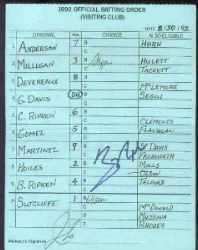1956 Topps # 84 Babe Birrer [WB] (Tigers)
| Grade |
EX/MINT to NEAR MINT |
| Book Value |
$ 10 |
| Our Price |
$ 11.95
Add to cart
|
![1956 Topps # 84 Babe Birrer [WB] (Tigers) cards value](/jpgs/no-image.jpg)

Below are short bits & pieces on sportscard & baseball trading card collecting.
Please wander around the website for more info, prices, values & images
on vintage baseball, football, basketball, hockey, sport and non-sports cards.
1948 Bowman Football Cards
Checklist & Values
1948 Bowman Football takes it's place in the early history of football cards.
While not as flashy as the 1935 National Chicles football issue the 1948
Bowman Football set had great players in real photographs !
The set was tiny (in both card size and number of cards) containing only
108 smallish 2-1/16" x 2-1/2" inch cards. The honor of top rookie in the
set is easily Sammy Baugh and there appear to be no variations in the set.
Note: You may be on that page right now.
|

1951 Bowman Football Cards
Checklist & Values
Bowman Gum Company had rights to produce NFL football cards from 1948 thru
1952. 1951 Bowman football cards were available in 6-card packs for a nickle
and single-card packs for a penny !!! Each with a piece of gum.
WHAT A BARGAIN !!!
The top rookie card in this set is of future Cowboys Hall-of-Famer Tom Landry.
Click for complete
1951 Bowman Football cards checklist, values and prices.
Note: You may be on that page right now.
|

Authentic Major League SIGNED
Game-Used LINEUP Cards (PSA)

These are the official lineup cards SIGNED BY THE MANAGER & given
to the home plate umpire before the game with the team's line-up
& batting order !!! Making them even neater, often managers made
lineup changes on these cards throughout the game.
These official lineup cards were SIGNED BY THE MANAGER and presented
to the home plate umpire before the game. They detailed the team's lineup and
batting order. Managers often made lineup changes on these cards throughout
the game, making them even more unique.
Collectors say "They are official documents of a particular game, so they are
absolutely historically relevant. The manager, he was the general in the war.
Imagine owning Eisenhower's list of who he wanted to go into battle, and then he
signed it !!! Imagine what that would be worth?"
The first dugout lineup cards were seen around 1960. Along with lineup
cards, most ended up in the trash after games, making them quite rare today.
MLB saw the light and started marketing them directly in the 2000's.
Astronomical prices have been paid for cards from special games.
$165,010 for the Red Sox dugout lineup card from Game 4 of the 2004 World Series.
$138,000 in 2007 for 1st ever All-Star Game batting order cards.
$ 40,000 for batting order cards and the pen used to fill them out from
Cal Ripken's 2,130th & 2,131st games.
Click for complete
Major League SIGNED Game-Used LINEUP cards
Note: You may be on that page right now.
|

Protecting and Storing your Card Collection
There are many different ways to protect, organize and store your sports cards.
Soft Sleeves
also called "penny sleeves" are the most basic protection for your cards.
Made of thin plastic, they come in packs of 100 and are very inexpensive.
Top Loads
are rigid plastic holders and a step up in protection over "soft sleeves".
Called top-loads because you place the card thru a thin opening at the top.
They come in many sizes for regular cards upto 8-1/2 x 11 for magazines and
even larger.
Screw-Down Acrylic Holders
These are sometimes used for better, more expensive cards. Small screws hold
two pieces of clear acrylic together. In a variety of sizes and thickness
that not only protect the card but can funciton as a paper weight or display
item.
There are also Single-Screw Screw-Downs that use only 1 screw to seal the holder.
They are easier to use and provide the same type of protectionas regular screwdowns
and they are also much less expensive costing as little as .30 in quantity
while 1 inch or 2 inch acrylic screw-downs can cost upto several dollars.
![1956 Topps # 84 Babe Birrer [WB] (Tigers) cards value](/jpgs/no-image.jpg)




 These are the official lineup cards SIGNED BY THE MANAGER & given
to the home plate umpire before the game with the team's line-up
& batting order !!! Making them even neater, often managers made
lineup changes on these cards throughout the game.
These official lineup cards were SIGNED BY THE MANAGER and presented
to the home plate umpire before the game. They detailed the team's lineup and
batting order. Managers often made lineup changes on these cards throughout
the game, making them even more unique.
These are the official lineup cards SIGNED BY THE MANAGER & given
to the home plate umpire before the game with the team's line-up
& batting order !!! Making them even neater, often managers made
lineup changes on these cards throughout the game.
These official lineup cards were SIGNED BY THE MANAGER and presented
to the home plate umpire before the game. They detailed the team's lineup and
batting order. Managers often made lineup changes on these cards throughout
the game, making them even more unique.
